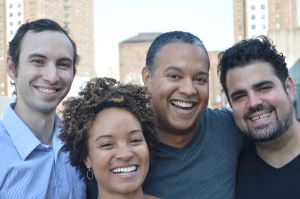A stupendous singer in the title role led the cast in the Opera Carolina‘s revival of The Flying Dutchman (Der fliegende Holländer) in celebration of the 200th birthday of the composer, Richard Wagner. Bass-baritone Greer Grimsley has a gorgeous deep voice with a natural expressive vibrato that gives pleasure each time he sings, whether the long soliloquy in the first act or the touching second act duet with his hoped-for mate and salvation, Senta. Grimsley’s career is approaching its zenith – this season he sang Wotan in the Ring cycle both at the Metropolitan Opera and at the Seattle Opera. No stranger to the Charlotte scene, Grimsley first appeared with Opera Carolina in Mozart’s Don Giovanni in 1998.
Senta, the angel who frees the Dutchman from his eternal wandering, is sung in this production by Elizabeth Beers Kataria in her first appearance at Opera Carolina. Gifted with a beautiful top register of unusual purity and power, the young singer made a believable Senta. Unfortunately, the acoustic quirks of the Belk Theater and the size of the orchestra in the immense pit conspired to cover most of the soft passages in the middle of her range – although I hasten to add that the second act duet with the Dutchman was lovely!
Erik, Senta’s cast-off ex-boyfriend was ably sung by tenor Jason Wickson, who could be heard over the orchestra. His burnished tenor and earnest acting gave gravitas to an otherwise light-weight character. Senta’s conniving father and a sea captain himself, Daland, was admirably sung by bass-baritone Kristopher Irmiter, a regular on the stage of Opera Carolina. His greed and impatience to see his daughter wed to the wealthy Hollander sent ripples of laughter through the large audience.
The role of Daland’s nameless steersman, who sang a lovely but short aria from the deck of the ship he was supposed to watch, was filled by Daniel Stein, a tenor with a pleasing voice. Stein also succumbed to the quirky acoustics of the hall and was at many moments difficult to hear. The ambiguous role of Mary, Senta’s nanny or governess, was sung with dramatic flair by mezzo-soprano Luretta Bybee.
The Opera Carolina Chorus, augmented by the Gay Men’s Chorus of Charlotte, was superb! The sailors’ chorus in the first act and especially at the beginning of the third act was outstanding. The ladies, not to be outdone, were also excellent as yarn-spinners in the second act and as townsfolk in the third act, where Maestro James Meena happily chose not to abridge the waltz-like celebrations.
The lighting and the projections of Michael Baumgarten and Fenlon Lamb added much to the constantly changing moods. Working within a traditional set design (on loan from the Arizona Opera), with an actual mock-up of a sailing vessel crossing the stage, projections on the scrim in front and on the back cyclorama were an integral part of the staging. An unusual innovation during the overture was a retrospective insight into Senta’s obsession with the legend of the Flying Dutchman, done with projections and showing the child Senta already fascinated by the dark tragedy of the Hollander.
The excellent Charlotte Symphony weathered some intonation problems during the overture, but emerged shining and intact. Maestro Meena led the ensemble with clear bold gestures. The acoustical problems are not his, but the orchestra did play fairly loudly and several of the mid-range vocal solos did not carry!
The huge orchestra pit sits in front of the stage (hardly, if at all, under the stage), meaning that the singers have to project across the pit before encountering the front row of audience. The directional nature of the hall is such that if a singer turned even a quarter to the right or left, the sound went in that direction, leaving the rest of us straining to hear. Where I was sitting, on the right front row of the Grand Tier Circle, I heard mostly horns, oboes and tympani – hardly the 34 string players. Several years ago, for Mozart’s Le nozze di Figaro, Maestro Meena solved the problem by placing the orchestra on-stage, behind the singers, who were 20 feet nearer the audience. But a Wagner-sized orchestra makes that impossible.
Repeat performances are on Thursday, March 27 and Sunday, March 30; for details, see the sidebar. A fascinating on-line tongue-in-cheek blog about Wagner and the history surrounding the creation of Der Fliegende Holländer can be found at “Brunnhilde’s Beat.”











